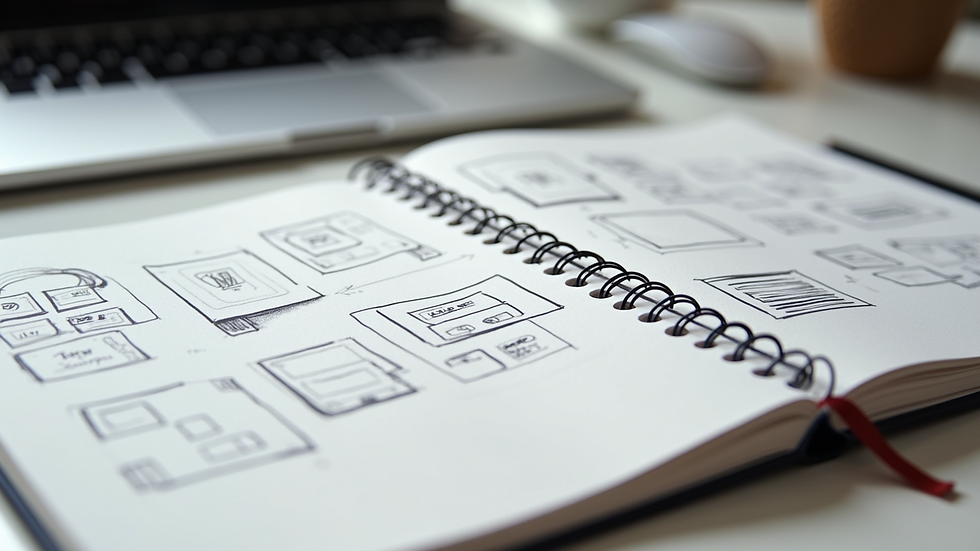Understanding the UX Design Process From Research to Launch
- Nelly Nikulina
- 5 days ago
- 4 min read

Creating products that users find enjoyable and easy to use is essential in today's digital world. The User Experience (UX) design process plays a key role in achieving this. By breaking it down into stages, from research to final launch, designers can craft effective, user-friendly solutions that truly meet user needs. In this article, we will delve into the UX design process, exploring each step in detail with specific examples and actionable insights.
Research
Research is the cornerstone of the UX design process. By understanding user needs, behavior, and motivations, designers set the stage for success. Common research methods include:
Surveys: Collecting data from a large group of users to gain quantitative insights. For example, a survey might reveal that 70% of users find a specific feature confusing.
Interviews: Conducting one-on-one conversations to gather qualitative insights. This can help uncover users' emotions and thoughts about a product.
Clearly defining the target audience during this phase is crucial. If you are designing an app for seniors, understanding their tech proficiency is vital. Similarly, performing a competitive analysis can spotlight strengths and weaknesses in rival products, informing your design choices effectively.
Define
After completing research, it’s time to define the problem. This phase involves analyzing the data to extract key insights and detect pain points. Designers create user personas, which are fictional representations of your target audience. For instance, if research shows that many users struggle with navigation, your user persona might include a busy parent who needs a straightforward experience.
A well-crafted project brief is also developed during this phase. It outlines objectives, constraints, and project scope. For example, if you aim to improve a fitness app for busy professionals, your brief may define the need for quick access to workout plans and minimal setup time.
Ideation
With clear insights in hand, designers enter the ideation phase, where creativity flourishes. Techniques such as:
Mind mapping: Organizing thoughts visually to explore connections.
Sketching: Quickly translating ideas onto paper to visualize concepts.
The goal here is to generate as many ideas as possible without criticism. For example, during a brainstorming session, a team might come up with 15 different features for a banking app that enhances user interaction. After the brainstorming, the team can narrow down ideas based on feasibility and user alignment.

Prototyping
Prototyping allows designers to turn ideas into tangible concepts. Prototypes can vary widely in fidelity, ranging from simple wireframes to interactive models.
Low-fidelity prototypes: These can be created quickly, often on paper or using tools like Balsamiq to start gathering initial feedback.
High-fidelity prototypes: These are more robust and interactive, demonstrating a near-final version of the product. Tools like Adobe XD or Figma are popular for this.
For example, using a low-fidelity wireframe might help discover layout issues before committing to a more complex design. User testing at this stage can provide insights that reveal what users find confusing or appealing.
Testing

Testing is vital for ensuring that the design meets user expectations. By observing users interacting with the prototype, designers can gather insights into usability.
Usability testing can take various forms:
Moderated sessions: Designers guide users through tasks while observing their behavior.
A/B testing: Two versions of a design are tested against each other to see which performs better.
For example, if 80% of users fail a task during testing, it signals a need for redesign or further investigation. Continuous iterative testing helps refine the design, ensuring that it aligns with user needs.
Implementation
Once the design is refined, implementation brings it to life. This phase requires close collaboration with developers to ensure the final product matches the original design.
Designers often prepare detailed specifications and style guides, which can include color codes and typography choices. For instance, if a color contrast ratio is essential for accessibility, documenting this is crucial for developers.
Quality assurance testing follows, where any bugs or inconsistencies are identified. This step is essential before the product goes live, helping avoid user disappointment due to technical errors at launch.
Launch
The launch phase signifies the end of the design process and the beginning of user interaction. The product is released to the market, but the journey doesn't stop there.
Post-launch monitoring is key to assessing how users interact with the product. Analytics tools can provide a wealth of data such as user retention rates, which industry studies suggest range from 20% to 35% on average within the first month. By closely monitoring this data, designers can inform future updates and improvements.
Final Thoughts
The UX design process is a comprehensive journey that requires careful attention to each stage, from initial research to the official launch. By understanding and following this structured approach, designers can create experiences that resonate with users and meet their actual needs.
In an ever-evolving digital landscape, effective UX design is more important than ever. By prioritizing user experience, you can ensure that your products not only stand out but also foster long-lasting user satisfaction.





Comments